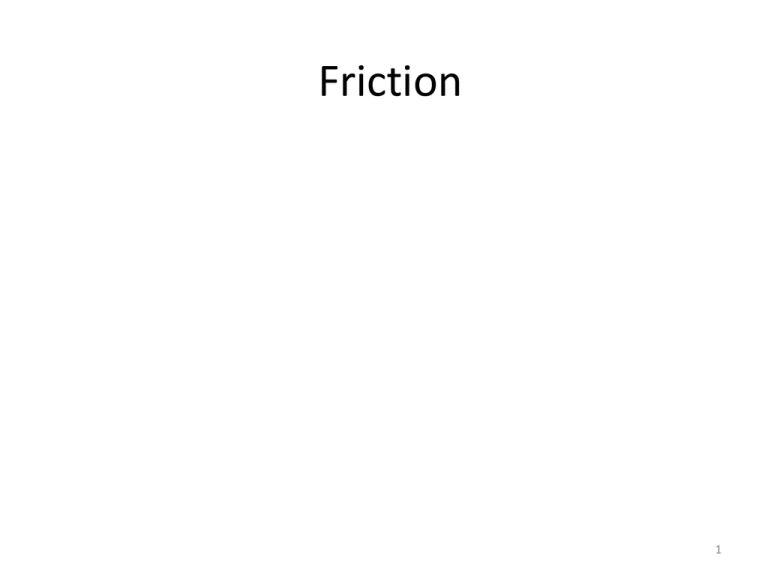Friction - WordPress.com
advertisement

Friction 1 Friction friction: The resistance to motion that occurs when the surface of two media or materials are in contact. 2 Friction friction: The resistance to motion that occurs when the surface of two media or materials are in contact. examples: solid on solid fluid on solid fluid on fluid 3 Friction Types of friction: 4 Friction Types of friction: static friction; frictional force that occurs between two surfaces that are not in motion relative to each other. 5 Friction Types of friction: 1. static friction; frictional force that occurs between two surfaces that are not in motion relative to each other. Force is of sufficient strength to prevent relative motion to each other. The bonds (Vander Whals Forces) between the two surfaces are sufficiently strong to prevent relative motion by opposing forces 6 Applications Involving Friction On a microscopic scale, most surfaces are rough. The exact details are not yet known, but the force can be modeled in a simple way. For kinetic – sliding – friction, we write: 7 Friction Types of friction: 2. kinetic friction (sliding friction): occurs when surface of one substance is moving (sliding) over the surface of a second substance. 8 Friction Types of friction: 2. kinetic friction (sliding friction): occurs when surface of one substance is moving (sliding) over the surface of a second substance. Sufficient to retard but not prevent the motion The bonds are sheared by a force opposing the friction will eventually stop the motion if the friction is not overcome by a sufficient counter force 9 Friction Types of friction: 3. rolling friction; when an object is rolling over another surface without slipping without slipping The surfaces in contact form static friction bonds The static bonds are broken by a prying mechanism rather than a shearing mechanism 10 Friction Types of friction: 3. rolling friction; This is a difficult type of friction to analyze. We will not cover rolling friction in depth 11 Friction • Measuring Friction; Frictional force = normal force ( coefficient of friction) Ff = F N μ FN = normal friction μ = coefficient of friction (NO UNITS) Two types of coefficients 1) static (μs) 2) kinetic (sliding) (μk) 12 Friction • Static Friction: – We observe that the frictional force is proportional to the normal force. For static friction: Ff ≤ FN (μs) – The static friction may not always be at maximum value. The strength of the frictional force varies with circumstance. – It will break when the maximum static frictional force is exceeded. Ff MAX = FN (μs) 13 Friction • Kinetic Friction: – When the static frictional forces are broken the two surface begin to move relative to each other 14 Friction • Kinetic Friction: – When the static frictional forces are broken the two surface begin to move relative to each other Fk = FN (μk) 15 Friction • Kinetic Friction: – When the static frictional forces are broken the two surface begin to move relative to each other Fk = FN (μk) Kinetic friction between two given surfaces is usually weaker than the static friction between the same two surfaces 16 Static Friction vs. Kinetic Friction • Kinetic Friction: 17 Friction • The applied force required to overcome the static friction will usually be greater than the kinetic friction. • As a result the applied force will cause the object to accelerate once the static frictional bonds are broken 18 Common Coefficients of Friction 19 Friction Example Wood Block 10 kg wooden block being pulled by a rope Fs = FN μs = 98N(0.58)= 56.8N 20 Friction Example Wood Block 10 kg wooden block being pulled by a rope When 56.8N of force is applied the wooden block , the static friction is broken 21 Friction Example Wood Block The static friction is immediately replaced by kinetic friction Fk = FN μk = 98N ( 0.40) = 39.2N 22 Friction Example Wood Block 56.8 N > 39.2N FNet = 56.8 N – 39.2N =17.6N 23 Friction Example Wood Block FNet = 56.8 N – 39.2N =17.6N FNet = m a 24 Friction Example Wood Block FNet = 56.8 N – 39.2N =17.6N a =Fnet /m = 17.6N/10Kg =1.76m/s2 25 Figure 4-20 Forces of static and kinetic friction 26 Figure 4-21 Pulling at an angle: a closer look at the normal force 27 28 The pulling force is divided into 1) lifting force 2 horizontal force 29 lifting force = sinθ(F) horizontal force = cosθ(F) 30 lifting force reduces the normal force this results in a reduction in the frictional force 31 Figure 4-21 Pulling at an angle: a closer look at the normal force




